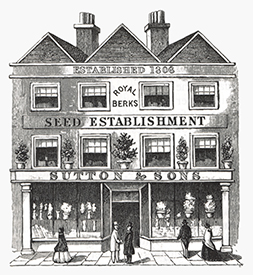Sunflowers have a long and fascinating history. Loved for their bright, ornamental flower heads, the edible seeds of these wildlife-friendly blooms are also transformed into a cooking oil used in kitchens all over the world. Learn more about this wild North American flower’s journey to become one of our all time favourites.
Browse our full range of sunflower seeds for more inspiration.
The origin of sunflowers
The wild sunflower (Helianthus Anuus) is a native of North America that was first cultivated some 3000 years BC in what is now Arizona and New Mexico. Archaeologists think it’s possible that the sunflower was used in the home before corn. The seed was ground or pounded into flour or squeezed to release the oil and used to make cakes and bread. Of course, just as we do now, the seed was also cracked and eaten as a snack – and a healthy one at that!
In addition, sunflowers were used to make a purple dye for textiles, body painting and other decorations. Medicinal uses ranged from snakebite antidote to skin and hair ointments. The magnificently strong, thick stalks were dried and used as building material.
How sunflowers came to Europe
At some time around 1500, Spanish explorers brought the plant to Europe where it became a popular ornamental. By 1716, an English patent was granted for squeezing oil from sunflower seeds and by 1769 there is reference to sunflowers being cultivated for oil production.
Enter the Russians – much credit is given to Peter the Great for developing oil production. By 1830 the manufacture of sunflower oil was being done on a commercial scale across the Russian Steppes. Popularity increased for a very practical reason. Most oily foods were forbidden by the Russian Orthodox Church during Lent. Sunflower oil, however, was not on the prohibited list and gained immediate popularity as a food.
By the early 19th century Russian farmers were growing two million acres of sunflowers. Then, by the late 19th century, Russian sunflower seed was back in the US and seed companies were advertising the ‘Mammoth Russian’ sunflower seed in catalogues. According to the International Sunflower Oil Association (ISA), Russia and Ukraine are still the world’s biggest producers of sunflower oil.

Suttons was established in 1806 and has supplied flower seeds to the nation ever since. Part of the sunflower’s golden history, Suttons quickly became one of the trusted suppliers of these popular flower seeds and today offers a wide range of varieties from single-stemmed ‘giants’ to multi-headed plants and low-growing plants suitable for containers. Any garden is graced with their presence, and they’re a great way for children to get interested in gardening.
If you want to know more, check out our quick guide to growing giant sunflowers.
References:
Albert A. Schneiter, ed. Sunflower Technology and Production (The American Society of Agronomy No. 34, 1997) 1-19
International Sunflower Association, I.S.A. 2019. International Sunflower Association. [Online]. [21 July 2019]. Available from: https://www.isasunflower.org/
Read our other latest blogs!
- From the plot: interview with @jessukgardendiaries
- How to grow spinach from seed
- Best fruits to grow in a small space garden
- From the plot: interview with @allotmentcooks
- Small space gardening: how to build a veggie tower
Last Updated on May 19, 2025 by Suttons Horticultural Team



